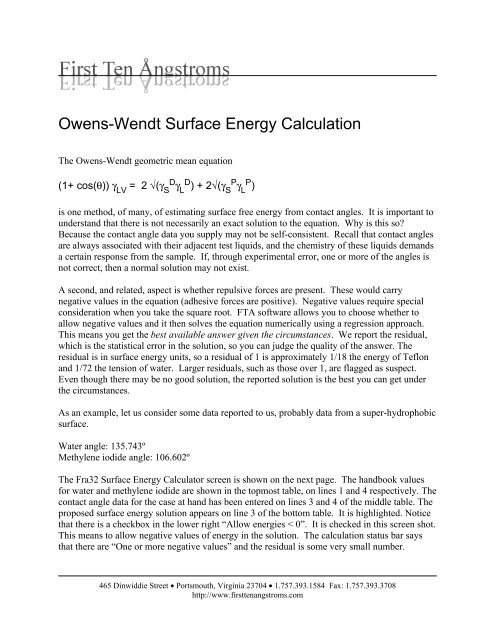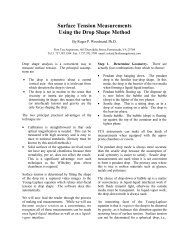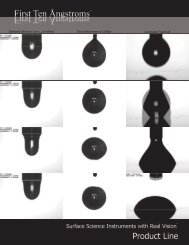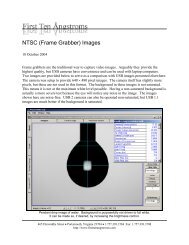Owens-Wendt Surface Energy Calculation
Owens-Wendt Surface Energy Calculation Example - First Ten ...
Owens-Wendt Surface Energy Calculation Example - First Ten ...
- No tags were found...
Create successful ePaper yourself
Turn your PDF publications into a flip-book with our unique Google optimized e-Paper software.
<strong>Owens</strong>-<strong>Wendt</strong> <strong>Surface</strong> <strong>Energy</strong> <strong>Calculation</strong>The <strong>Owens</strong>-<strong>Wendt</strong> geometric mean equation(1+ cos(θ)) γ LV= 2 √(γ S D γ L D ) + 2√(γ S P γ L P )is one method, of many, of estimating surface free energy from contact angles. It is important tounderstand that there is not necessarily an exact solution to the equation. Why is this so?Because the contact angle data you supply may not be self-consistent. Recall that contact anglesare always associated with their adjacent test liquids, and the chemistry of these liquids demandsa certain response from the sample. If, through experimental error, one or more of the angles isnot correct, then a normal solution may not exist.A second, and related, aspect is whether repulsive forces are present. These would carrynegative values in the equation (adhesive forces are positive). Negative values require specialconsideration when you take the square root. FTA software allows you to choose whether toallow negative values and it then solves the equation numerically using a regression approach.This means you get the best available answer given the circumstances. We report the residual,which is the statistical error in the solution, so you can judge the quality of the answer. Theresidual is in surface energy units, so a residual of 1 is approximately 1/18 the energy of Teflonand 1/72 the tension of water. Larger residuals, such as those over 1, are flagged as suspect.Even though there may be no good solution, the reported solution is the best you can get underthe circumstances.As an example, let us consider some data reported to us, probably data from a super-hydrophobicsurface.Water angle: 135.743ºMethylene iodide angle: 106.602ºThe Fra32 <strong>Surface</strong> <strong>Energy</strong> Calculator screen is shown on the next page. The handbook valuesfor water and methylene iodide are shown in the topmost table, on lines 1 and 4 respectively. Thecontact angle data for the case at hand has been entered on lines 3 and 4 of the middle table. Theproposed surface energy solution appears on line 3 of the bottom table. It is highlighted. Noticethat there is a checkbox in the lower right “Allow energies < 0”. It is checked in this screen shot.This means to allow negative values of energy in the solution. The calculation status bar saysthat there are “One or more negative values” and the residual is some very small number.465 Dinwiddie Street • Portsmouth, Virginia 23704 • 1.757.393.1584 Fax: 1.757.393.3708http://www.firsttenangstroms.com
2The dispersive result (γ S D ) is 6.432mN/m and the polar result (γ S P ) is -0.0474mN/m.Notice the handbook values for the test liquids. If you use different values, your resultswill be different.We also ran this under the assumption that negative energies were not allowed. Theresults are shown on the next page. The dispersive result is 6.047mN/m and the polarresult is 0. But the residual is now 1.847mN/m, a considerable fraction of the answer.Which do you prefer: high residual or negative values? Not a nice choice.Another worker proposed that the correct answer was 7.25 dispersive and 0.09 polar.Let's substitute all three sets (FTA with negative values, FTA without negative values,and customer's) back into the original equation set and see how they balance.465 Dinwiddie Street • Portsmouth, Virginia 23704 • 1.757.393.1584 Fax: 1.757.393.3708http://www.firsttenangstroms.com
3Original equation, written for both water and methylene iodide, below. The left handside will be the same for all three candidates since the contact angles are the same.(1+ cos(θ)) γ LV= 2 √(γ S D γ L D ) + 2√(γ S P γ L P )FTA, Negative Values:Substituting in, we have for water first and methylene iodide second,(.283783) 72.8 = 2 √ (6.432 x 21.8) + 2 √ (-0.0474 x 51)(.712278) 50.8 = 2 √ (6.432 x 50.8) + 2 √ (-0.0474 x 0)20.659 = 23.682 – 3.109 = 20.572 (applying negative values repulse)36.285 = 36.152 + 0 = 36.152Unbalances in equations are 0.087 and 0.133.465 Dinwiddie Street • Portsmouth, Virginia 23704 • 1.757.393.1584 Fax: 1.757.393.3708http://www.firsttenangstroms.com
4FTA, No Negative Values:(.283783) 72.8 = 2 √ (6.047 x 21.8) + 2 √ (0 x 51)(.712278) 50.8 = 2 √ (6.047 x 50.8) + 2 √ (0 x 0)20.659 = 22.963 + 0 = 22.96336.285 = 35.053 + 0 = 35.053Unbalances in equations are -2.304 and 1.232.Customer's(.283783) 72.8 = 2 √ (7.25 x 21.8) + 2 √ (0.09 x 51)(.712278) 50.8 = 2 √ (7.25 x 50.8) + 2 √ (0.09 x 0)20.659 = 25.144 + 4.284 = 29.42836.285 = 38.382 + 0 = 38.383Unbalances in equations are -8.769 and -2.097. As it stands, this is the worst fit.File: <strong>Owens</strong><strong>Wendt</strong><strong>Surface</strong><strong>Energy</strong><strong>Calculation</strong>.doc465 Dinwiddie Street • Portsmouth, Virginia 23704 • 1.757.393.1584 Fax: 1.757.393.3708http://www.firsttenangstroms.com






